The Renaissance - Why this period is so Important and Memorable
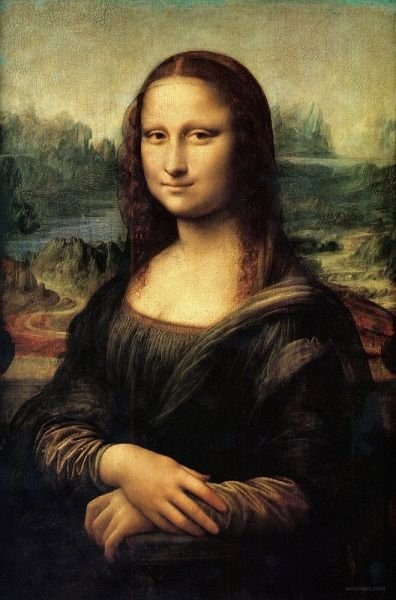
A breakthrough in the social and cultural development of the European countries from the 14th to the 17th century, when they came out of the Middle Ages, forming the features of modern European civilization. The term Renaissance is used to mean the increased interest in antiquity. The Renaissance is reflected in profound changes and refresher processes that began at the earliest in Italy (13 c.). At their core are the emergence of capitalist relations in the economic life, the emergence of the bourgeoisie and the hired workers, the secular intelligentsia. Free from theology and scholasticism, science evolves based on rationalism, observation, experience, exact calculations. In the natural sciences, revolutionary achievements were made by Leonardo da Vinci, N. Copernicus, G. Galilei, Paracelsus and other distinguished scientists. Epochal importance is the beginning of book printing, the acquisition of new natural sources of energy, the discovery of America and the sea routes to India (see Great Geographical Discoveries), the invention and improvement of firearms, machines, etc. Europe becomes a leading force in the economic, political and cultural development of the world. Bright and impressive are the changes in spiritual culture, literature and the arts. The most important features of the Renaissance culture are the secular idiot and humanism. Thinkers and creative artists in the Renaissance abandoned the theocentric views inherent in the Middle Ages, studying and glorifying man as a real earthly being, the free personality with its feelings, aspirations and creative expressions. The beginnings of the Renaissance in the literature first appeared in Italy (Dante), later Renaissance formed in the works of F. Petterka, Boccaccio, L. Ariosto, T. Tasso. Western European literatures developed under the influence of the Italian Renaissance and the scientific discoveries and reached remarkable peaks in the works of Lope de Vega, M. de Cervantes, W. Shakespeare, F. Rabela, the poets of the Pleiades. A deep breakthrough was accomplished through the Renaissance and in the theater, music, and other areas of man's spiritual activity. The term Renaissance is associated with Italian architecture and art from 1420 to the middle of the 16th century; Proorenesans means the beginnings of the Renaissance in the 13th-14th centuries (seeScien School, Giotto). The largest centers of the Renaissance are Florence (see the Florentine School), Venice (see Venice School) and Rome, the Duties of Mantua, Urbino and Ferrara. Stages: Early Renaissance (1420-1500) - Florence, Tuscany (F. Brunelleles, L. Alberti, Donatello, Mazaccio, etc.), mature Renaissance, Renaissance (1500-40) - Florence, Rome, Venice (D. Bramante, Leonardo da Vinci, Michelangelo Buonaroti, Raphael), late Renaissance (16th century) - J. Sansovino, A. Paladio, Giorgio, Titian, P. Veronese. The creative process is associated with the individual-personal beginning (unlike the Middle Ages). Compositions made in the spirit of humanism, realistic portraits, landscapes are being created. World-class construction dominates - public buildings, palaces, town houses. Typical are the dismemberment of wall panels, arcades, colonnades, arches, domes; logical proportionality, harmony and clear tectonics, based on the laws of perspective, proportions. Urban development is developing. Large-scale architectural ensembles are created, subject to an overall artistic conception. The Medecins in the art of the Renaissance in Italy are the Medici and the Popes from Julius II to Leo X. In other countries the Renaissance is manifested after the enactment of the Italian Renaissance principles and their association with local (Gothic) traditions. The French Renaissance, the Flemish painters, the Dutch Renaissance, the German Renaissance, the Renaissance English, the Spanish Renaissance (the "Platerasque" style with rich sculptural decoration) and others do not coincide in time and have national peculiarities .
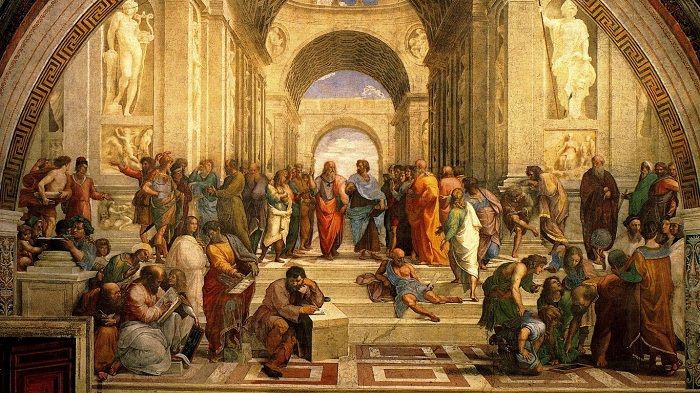
The School of Athens, a fresco in the Vatican, by Raphael
Renaissance (Renaissance - Renaissance) - the age of the culmination of culture in the Western European countries in the XV-XVI century. Revival is not only in fine arts and architecture, but also in science, literature, philosophy. Key features of Renaissance cultural development are the return to the values ??and forms of the Greek and Roman Antiquity, the development of the linear perspective in painting and the gradual reform of the education system. Stages in the Renaissance: Proto-renesans - XIV. The brightest brands are Pizzano, Simone Martini, Chimbuu, Giotto, Dante Algieri and others. Early Renaissance - 1420-1500. (Florence, Tuscany) - Donatello, Botticelli, Mazaccio, Tomazo di Giovanni di Simone Guidi and others. Mature Renaissance - 1500-1540ã. (Florence, Rome, Venice) with representatives - Leonardo da Vinci, Michelangelo, Bramante. Late Renaissance - 16th Century - Palladio, Giorgione, Titian, Veronese. The Renaissance period of the Netherlands, Germany and France is divided into a stylistic direction called the North Renaissance. Leading representatives are Durer, Holbain Junior, Lucas Old, Pierre Breogel Older.
Giotto di Bondone - Giotto - (1266-1337) Florence. He is considered the first of a number of great artists to precede the Italian Renaissance. He is considered a reformer in painting. Giotto opens the way the movement evolves: it fills the old religious forms with secular content. It sets the beginning of the gradual transition from plane images to volume and relief, increases realism, using the interior in its paintings. It is best known for the frescoes in the Chapel (Chapel) in Padua dedicated to episodes of the life of Our Lady and Jesus; frescoes in the Franciscan churches in Assisi and Rimini. Other famous frescoes are those in the Santa Croce Basilica (Florence). Besides frescoes, Giotto creates a whole series of "cavalry" works. These are cruciform crucifixes, altar paintings and polyphyties (two or more paintings with related storyline). More famous of them are: "The painted cross-crucifixion" in Santa Maria Novella, altar image "Stygmatization of Saint Francis". Apart from a painter, Giotto is also an architect. The bell tower of Santa Maria del Croce, one of the most beautiful in Italy, was built according to plans by Giotto, and its function is rather decorative.
Donatello - (1386-1466) Florence. One of the most famous Italian sculptors of the early Renaissance era, the founder of the individual sculpture image. Based on ancient classical forms, Donatello develops in the Renaissance sculpture the free-standing figure, the naked body, the sculptural figural composition and the horse statue. His teachers are Brunelleski (architect) and Lorenzo Giberti (sculptor). The most significant works of Donatello are: David (bronze), Saint George, Tomb of John XXIII in the Florentine Baptistery, Gatamelaata in Padua and others. One of his first works is orelef (images made of volumes, protruding or concave on a fairly flat background) of fine-grained stone, located in the church of Santa Croce, in Florence and depicting the Annunciation. The bronze statue of David, founded in the 1440's by Donatello, is one of the most famous sculptures at present. David is presented with a mysterious smile, posing after he cut off Goliath's head. This is the first bronze statue of the Renaissance and the first of its kind to portray a standing naked man.
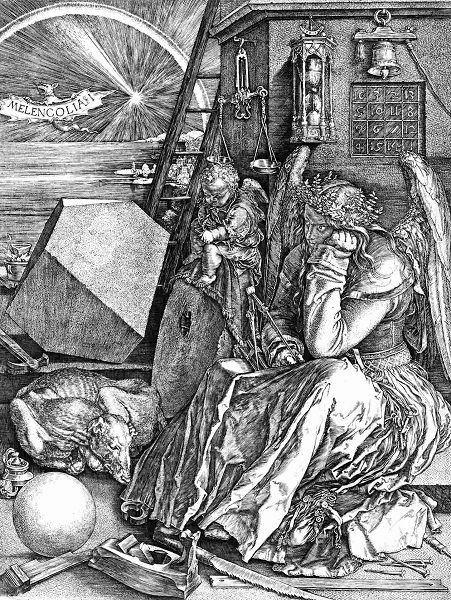
Albrecht Durer, Melancholia
Albrecht Durer (1471-1528) Nuremberg, Germany. A German artist, artistic and mathematician, one of the most prominent representatives of the North Renaissance. He is famous for his printed engravings, in the field of which he provokes a real revolution. The most famous of them are: "The Four Horsemen of Apocalypse", "The Knight, the Devil and Death", "Saint Jerome", "Melancholy". His are the mathematical works related to the graphic representation of the ellipse, parabola and hyperbola. Durer devotes much time to studying the anatomy of the human body and, in particular, the naked figure. Besides graphic, he also has many picturesque paintings, portraits, self portraits and watercolors.
Common feature
The Renaissance is a new cultural paradigm for its time, a result of the cardinal changes in social relations in Europe.
The growing importance of the republics has led to an increase in the influence of the classes that have not yet participated in feudal relations: craftsmen and craftsmen, merchants and bankers. All of them are alien to the hierarchical value system created in the Middle Ages, to a great extent - to church culture and its ascetic spirit of humility. This leads to the emergence of humanism - a social-philosophical movement that views man, his personality, his freedom, his active and creative activity as the highest value and criterion for assessment by public institutions.
In the cities began to appear secular centers of art and science, whose activity is beyond the control of the church. The new worldview perspectives turn to Antiquity, seeing it as an example of humanistic and non-ascetic relations. Inventing the book printing in the middle of the 15th century plays a huge role in the spread of ancient heritage and new outlooks across Europe.
The Renaissance arose in Italy, where its first signs were recorded in the 13th and 14th centuries (in the Pizzano, Giotto, Orcana, etc.), but it was only established in the 1920s. In France, Germany and other countries, this movement began much later. By the end of the 15th century, the Renaissance reached its largest prosperity. In the 16th century there was a crisis in the ideas of the Renaissance, which resulted in the emergence of manners and baroque styles.

The cathedral of Florence, by Giorgio Vasari, Federico
Stages
Proto-Renaissance
Towards the 13th and the beginning of the 14th century, Nicholas Piazano, Arnoldo di Cambio, Ducho di Buoninseia, Simone Martini, Chimbuwe, Giotto, Dante Alighieri.
The pre-Renaissance is closely related to the Middle Ages, Romanesque and Gothic traditions, this period is the preparation of the Renaissance. It was divided into two sub-periods: to the death of Giotto di Bondone and after 1337. The most important discoveries, the most remarkable artists, are living and working during the first period. The second is related to the plague epidemic ravaging Italy. All discoveries are made at an intuitive level. At the end of the 13th century, the main temple facility was built in Florence - the cathedral of Santa Maria del Fiore, the author of which was Arnoldo di Cambio, later Giotto's work, designed the Florentine cathedral campaign.
Above all, Predrenesanza's art appears in the sculptures of Nicholas and Giovanni Pizano, Arnoldo di Cambio, Andrea Pizano). The painting is represented by two art schools: Florence (Chiambue, Giotto) and Siena (Ducho, Simone Martini). The central figure becomes Giotto. The Renaissance artists consider him a reformer of painting. Giotto discovers the way in which the development of the movement begins: the filling of religious forms with secular content, a gradual transition from flat images to volume and relief, increase of realism, depiction in the picture of the interior.
Early Renaissance
1420 - 1500 - Florence, Tuscany with representatives Filipo Brunellesky, Lorenzo Giberti, Leon Batista Alberti, Donatello, Mazaccio and others.
The period of the so-called Early Renaissance encompasses the time from 1420 to 1500 in Italy. During these eighty years, art is not yet completely separated from the past, but tries to impart to it elements borrowed from classical antiquity. Only afterwards, and less so, under the influence of ever-changing living and cultural conditions, the artists completely broke with the medieval foundations and bravely used the images of ancient art, both in the general concepts of their works and in their details.
When art in Italy resolutely takes on the role of classical antiquity, in other countries it has long preserved the traditions of the Gothic style. To the north of the Alps, and also to Spain, the Renaissance only arrived at the end of the 15th century, and its early period lasted until the middle of the next century.
.jpg)
Last Judgement, by Michelangelo
Mature Renaissance
1500 - 1540 - Florence, Rome, Venice with representatives of Donato Bramante, Leonardo da Vinci, Michelangelo Buonaroti, Rafaello. The third period of the Renaissance - the time of the most splendid development of its styles - is accepted to be called the Expanded, the Risen Renaissance. He continued in Italy approximately from 1500 to 1527. / The Moment of the Rise of Rome (1527) by the troops of Carl V /. At that time, the center of influence of Italian art moved from Florence to Rome, thanks to the uprising of the Pope's throne of Julius II, a very ambitious, brave and enterprising man who attracted to his court the best Italian artists who occupied numerous and important projects and an example of love for arts. With this pope and his close successors, Rome becomes like the New Athens from Pericles' time: it houses many monumental buildings, magnificent sculptures, frescoes and paintings, still considered masterpieces of painting; all three spheres of art harmoniously go hand in hand, helping each other and interacting with each other. Now, ancient art is studied with much greater grounds, reproduced with greater severity and consistency; tranquility and dignity replace the playful beauty that represents the aspiration of the preceding period; the reminder of the medieval disappears completely, and the classic footprint marks all the works of art. But the imitation of antiquity does not interfere with the aspirations of the artists for self-determination, and they, with great ingenuity and living fantasy, freely process and change what they think fit to borrow from ancient Greek-Roman art.
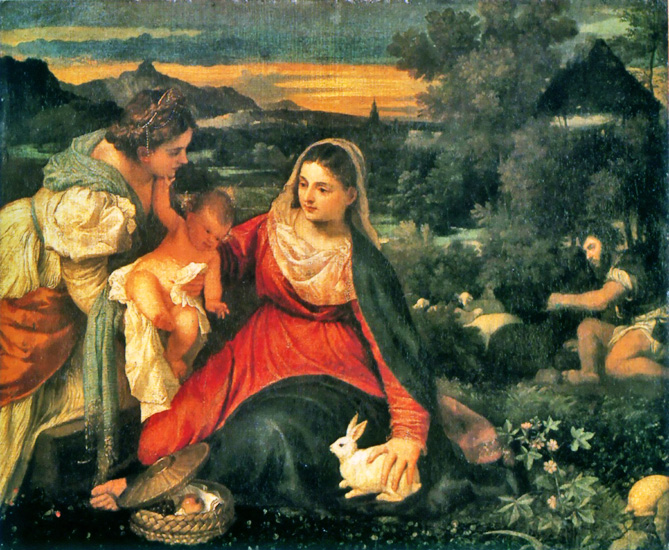
Madonna and Child with St. Catherine and a Rabbit, Titian
Late Renaissance
16th Century - Andrea Paladio, Giorgione, Titian, Paolo Calliari Veronese.
The late Renaissance in Italy covers the period from the 1530s to the 1590-1620s. Some researchers attribute themselves to the Late Renaissance and the 1630s, but this position provokes controversy among art historians and historians. The art and culture of that time are so varied in their manifestations that their deduction under one denominator can only be made with great conditionality. For example, the British Encyclopedia writes that "The Renaissance as a complete historical period ends with the fall of Rome in 1527". Southern Counter-Reformation triumphs in southern Europe, which looks with suspicion of any freedom of thought, including the portrayal of the human body and the resurrection of the ideals of Antiquity as the cornerstones of Renaissance ideology. Ideological contradictions and the general feeling of a crisis in Florence lead to a "nerve art" of shaded colors and broken lines - maniritis. In Parma, where Corregidos worked, manners did not come until after his death in 1534. In the artistic traditions, Venice had its own way of development, until the end of the 1570s there worked Titian and Palladio whose work had little to do with the crisis in the art of Florence and Rome.
The Italian Renaissance has practically no influence on the other countries until 1450. After 1500 the styles spread throughout the continent, but many late-gothic influences remain as far as the Baroque era.
The Renaissance period on the territory of the Netherlands, Germany and France is agreed to be divided into a distinctive style that has some differences with the Renaissance in Italy and which is called the North Renaissance.
Mercury , Benvenuto Cellini
The most significant differences in painting are: unlike Italy, the traditions and customs of Gothic art have long been preserved, less attention is paid to the ancient heritage and the knowledge of man's anatomy.
Leading representatives are Albrecht Durer, Hans Holbein Jr., Lucas Cranach Old and Pierre Bruegel Old. From the pre-Renaissance spirit, some works of late Gothic masters such as Jan van Eyck and Hans Memming have been infiltrated.
Historically
It is called a breakthrough because in the 14th and 17th centuries the social and cultural development of the European countries came out of the Middle Ages and the characteristics of the modern European civilization were formed. The term Renaissance - a revival adopted to mean the increased interest in antiquity, but with the attitude of innovation. The renovation process began around the 13th century in Italy. In this extremely dynamic period, specific socio-economic relations are emerging, the bourgeoisie and the intelligentsia form. This is the period of revolutionary achievements. The contributions of Leonardo da Vinci, Nicolas Copernicus, Galileo Galilei, Paracelsus, Michelangelo Buonarroti and other distinguished artists and scientists have left a clear trace and predetermined many paths of development in science and art. The press, the new sources of energy, the great geographic discoveries, the invention and the improvement of the firearms, etc. are pervasive for society. This is also the period in which Europe becomes a leading economic, political and cultural power.
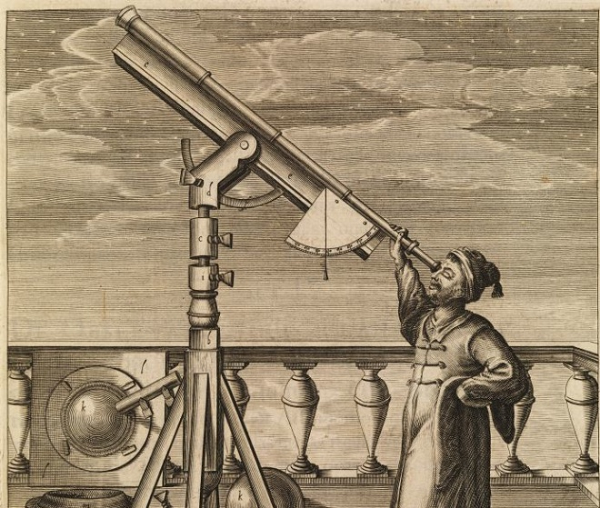
Science
The development of knowledge in the 14th-16th centuries significantly influenced people's perception of the world and the place of man in it. The great geographic discoveries, the heliocentric system of Nicholas Copernicus, change the notion of the dimensions of the Earth and its place in the universe, and the works of Paracelsus and Andreas Vesaleus, in which, for the first time since antiquity, attempts were made to study the structure of the human body and the processes in it, set the beginning of scientific medicine and anatomy.
Major changes also occur in social sciences. In the writings of Jean Bocden and Niccollo Machiavelli, the historical and political processes are first seen as a result of the interaction of different groups of people and their interests. Attempts have been made to discover the "ideal" social fabrication, such as Thomas Mori's Utopia and Tomazo Campanella's "The City of the Sun". Thanks to the interest in Antiquity, many ancient texts have been restored, checked and printed. Almost all humanists, anyway, deal with the study of classical Latin and ancient Greek.
In general, the predominant pantheistic mystique of this Renaissance era creates an unfavorable ideological background for the development of scientific knowledge.
The final formation of the scientific method and the subsequent scientific revolution in the 17th century are related to the movement of the Reformation.
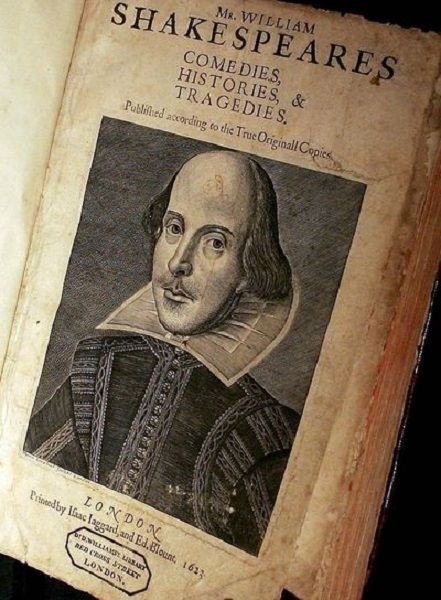
Literature
Changes in culture, literature and the arts do not give way to changes in the economic branch. Creativity through the Renaissance is of a secular and humanistic nature, and the artists themselves abandon the theocentric views and portray man as a real earthly being.
The renaissance in the literature begins with Dante, continues with Petraka, Giovanni Bocaccio, Ludovico Ariosto, Torcato Tasso. Western European literature developed under the influence of the Italian Renaissance and the scientific discoveries and reached the apogee in the works of Lope de Vega, Miguel de Cervantes, William Shakespeare, Francois Rabela.
As the originator of the Renaissance era in literature, it is accepted to consider the Italian poet Dante Alighieri (1265--1321), revealing the essence of the people of that time in his work "Comedy", which is later called "Divine Comedy". Francesco Petralca's love sonnets (1304-1374) discover the depths of man's inner peace, the richness of his emotional life. In the 14th-16th centuries, the Italian literature survived the poetry of Petralka, the novels of Giovanni Bocaccio (1313-1375), the political treatises of Nichola Machiavelli (1469-1527), the poems of Ludovico Ariosto (1474-1533) and Torquato Tasso (1544- 1595) put it in the number of "classical" (along with ancient Greek and ancient Roman) literatures for other countries.
The Renaissance literature is based on two traditions: folk poetry and "book" ancient literature, so often the rational beginning of it combines with poetic fiction, and comic genres are gaining popularity. This is particularly evident in the great literary monuments of the era: Boccaccio's Decameron, Miguel de Cervantes' Don Quixote, or Francois Rabela's Gargantua and Pantagruel.
The Age of the Renaissance is connected with the emergence of national literatures - unlike the Middle Ages literature, created mainly in Latin. Widespread drama and drama. The most famous playwrights of that time are William Shakespeare (1564-1616, England) and Lope de Vega (1562-1635, Spain).
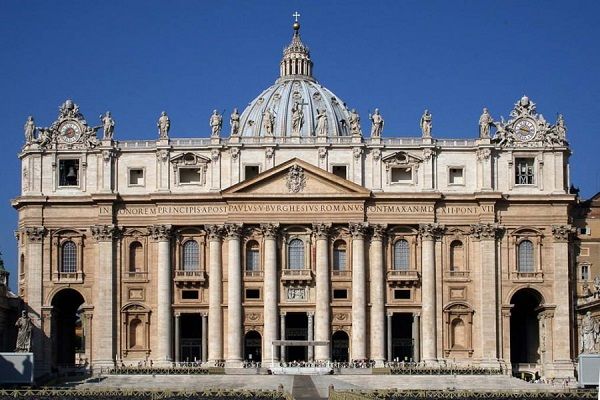
St.Peters Basilica in Vatican City
Architecture
The Renaissance in architecture began in 1420 and continued until the middle of the 16th century, passing through Proorenesansa (the beginning of the Renaissance in 13-14th century architecture) with the formation of the Sienna School, Giotto and others. The construction focuses mainly on public buildings, palaces, town houses, etc. of a secular nature. Typical are the ordered partitioning of wall panels, arcades, colonnades, domes, logical proportions, harmonicity and clear tectonics, based on the laws of perspective and proportions. This is a period for a strong urban development. Large-scale architectural ensembles are created, subject to an overall artistic conception.
.jpg)
Temple of Vesta, Rome
Famous architects
Filippo Brunelleski (1377-1446), a founder of Renaissance architecture, develops the theory of perspectives and the architectural order system, returns many elements of ancient architecture into construction, creates the first of many centuries domes (the Florentine Council), and to this day dominating the panorama of Florence .
Leon Batista Albert (1402-1472), a theoretician of Renaissance architecture, the creator of her overall concept, rethinks motifs from the Early Christian basilicas of Constantine the Great, at Palazzo Rucellai creates a new type of urban residence with a rustic facade divided by several pilasters .
Donato Bramante (1444-1514) - a pioneer of the architecture of the Jolly Renaissance, a master of centric compositions with ideally measured proportions.
Michelangelo Buonaroti (1475-1564) - the most famous architect of the Late Renaissance, is conducting grandiose construction works in the papal capital; in his buildings, the plastic beginning is expressed in dynamic contrasts, in a magnificent tectonic precursor of the Baroque art (St. Peter's Council, Laurencyana Library Stairs).
Andrea Paladio (1508-1580) - the founder of the first phase of classicism, known as paladinism; with an account of the specific conditions, endlessly uses different combinations of the ordinal elements; a supporter of the open ordinate architecture, which serves as a harmonious continuation of the surrounding environment, natural or urban (Palladian villas); working in the Republic of Venice.
Behind Italian borders, Italian influences lay on local medieval traditions, creating national Renaissance styles. The Iberian Renaissance is characterized by the preservation of Gothic and Mauritanian heritage (see Platera and Manuelino). In France, the Age of Renaissance leaves monuments in the form of the wonderfully decorated Lusarian castles with Gothic sloping roofs; the French Renaissance is considered to be the Shambor Castle of Francis I. Velizabeth England architect Robert Smithson designs rational-rectilinear residential buildings with huge windows that flood the interior with light (Longglitt, Hardwick Hall).
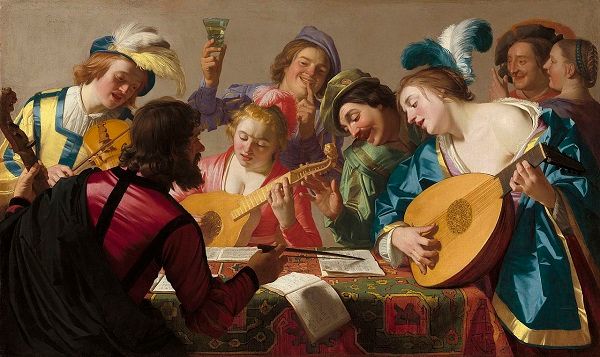
Musicians, ca 1600
Renaissance music
In the era of the Renaissance, professional music loses its character of purely ecclesiastical art and experiences the influence of folk music, penetrating a new, humanistic attitude towards the world. A high level reached the art of vocal and vocal-instrumental polyphony in the work of Ars nova (New Art) representatives, in Italy and France in the 14th century, in the newer polyphonic schools: the English - 15th, the Dutch - 15-16 c., Roman, Venetian, German, Polish, Czech, etc. - 16 in.
There are different genres of secular musical art - the French and Italian villas, the villas in Spain, the ballad in England, the madrigal that originated in Italy (Luca Marrentzio, Jacob Arcadelt, Jesualdo da Venosa) and received universal distribution, the French multi-song (Cleman Jeanneken , Claude Leijon). The worldly humanist aspirations also penetrated into the cult music - in the Franco-Flemish masters (Jossen de Pre, Orlando di Lasso) - in the art of the composers of the Venetian school (Andrea Gabrielli and J. Gabrielli).
In the period of the Counter-Reformation, the question of avoiding polygamy in the religious cult is considered, and only the reform of the head of the Roman school, Giovanni Piruluigi Pallestina, holds the Polyphony about the Catholic Church in a "clear" and "clear" form. At the same time, some of the valuable conquests of secular music from the Renaissance era are reflected in Pasteur's art.
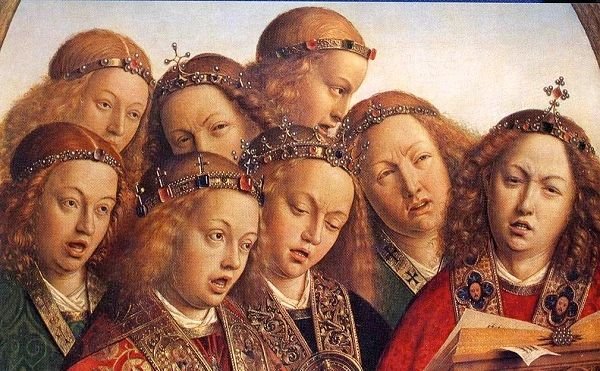
**Jan van Eyck The Ghent Altarpiece Singing Angels **
In Italy, the art of drawing tools of bows, rich in expressive abilities, blossoms. The clash of different aesthetic views is manifested in the "struggle" between two types of bows - the viola in the aristocratic circles, the icon - a tool of national origin. The era of the Renaissance ends with the emergence of new musical genres - solo songs, canto, oratorio and opera, which contribute to the gradual establishment of the homophone style.
Historiography of the Renaissance
The term was first used retrospectively by Italian artist and critic Giorgio Vasari (1511-1574) in his book Life of the most famous painters, architects and architects (published 1550). In it, Vasari attempts to define what he calls the termination of barbarism and the incompetence of Gothic art: the arts were in decline after the collapse of the Roman Empire and only with Tuscan artists, such as Chimbuwe and especially Giotto (1267-1337) and a revival of Italian art, largely due to the rediscovery of the art of antiquity.
However, the word Renaissance became popular only in the 19th century, when the French word Renaissance was spread as a description of the cultural movement that began in the late 13th century. Specifically, the Renaissance was first defined by French historian Jules Micele (1798-1874), in his History of France, published in 1855. About Michelle The Renaissance is more a development in science than in art and culture, and this is a period ranges from Columbus to Copernicus and Galileo Galilei, that is, from the end of the 15th century until the middle of the 17th century. Mishle distinguishes between what he calls the "strange and frightening" Middle Ages and the democratic values ??that he, as a Republican, feels to be characteristic of the Renaissance. As a French nationalist, Mishle understands the Renaissance primarily as a French movement.
_-_The_Last_Supper_(1495-1498).jpg)
Leonardo da Vinci, The Last Supper
The Swiss historian Jacob Burkhardt (1818-1897) in his book The Culture of the Italian Renaissance, on the contrary, defines the Renaissance as the period between Giotto and Michelangelo in Italy, between the 14th century and the middle of the 16th century. He sees in the Renaissance the manifestation of the modern spirit of individualism that has been stifled in the Middle Ages. His book has been quite popular and influential on today's understanding of the Italian Renaissance. However, Burkhard was accused of having created a Vighean linear perspective on the Renaissance, seeing the foundations of the modern world.
Recently, historians have less and less desire to define the Renaissance as a historical age and even as a coherent cultural movement. For example, Randolph Starr says:
"More than a period with a certain beginning and end, and consistent content between the two, the Renaissance can (and is usually seen) as a movement from practices and ideas to which specific groups and identities respond differently at different times and in different places. In this sense, it is a network of diverse, sometimes encountered in certain points, sometimes conflicting cultures, but not a single, time-limited culture. "
Loads of information. Thanks. Love it. @daydreaming Followed